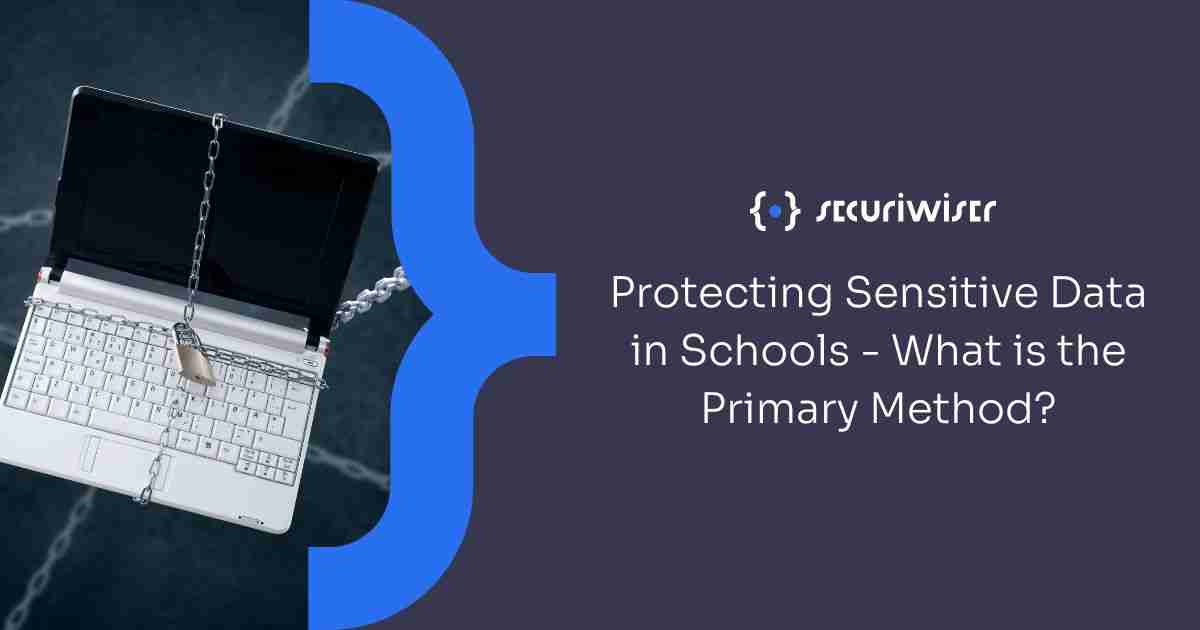Protecting Sensitive Data in Schools: What is the Primary Method?
Blog / Protecting Sensitive Data in Schools: What is the Primary Method?
4 MIN READ


Protecting sensitive data in the digital age is a complex and challenging task, particularly when poor data management, network security, encryption, and endpoint protection are used. As cyberattacks continue to increase, it is essential to implement stronger cybersecurity measures. This article will discuss the most effective ways to safeguard your most critical information, whether it is on an individual or organisational level. The consequences of losing vital data can be severe, such as identity theft, monetary loss, or exposure of classified information.
What is Sensitive Data?
In a school setting, sensitive data refers to any information that, if accessed or disclosed without authorization, could cause harm to students, staff, or the school organisation. This type of data, such as confidential student information, requires advanced security measures to prevent unauthorised access by hackers or malware.
To ensure the safety and privacy of students, sensitive data is usually kept secure and only accessible to those who have been granted permission, such as teachers, administrators, and authorised staff.
Examples of sensitive data in a school setting include student personal information, such as social security numbers or credit card information, as well as confidential school information, such as student records and disciplinary records.
Importance of Protecting Data
In UK schools, it is crucial to understand the importance of always protecting sensitive data, both when it is stored and when it is transmitted. This includes encrypting the data to prevent unauthorised access, as well as implementing strict access controls to ensure that only authorised individuals, such as teachers, administrators, and authorised staff, can access the data.
Additionally, it is important for schools to regularly monitor their systems and networks for any suspicious activity and have incident response plans in place to respond to any security breaches quickly and effectively.
Examples of sensitive data in a school setting that must be protected include:
• Student personal information such as legal information, financial, banking, or credit card information
• Confidential school information such as student records, disciplinary records, and academic performance
• Biometric data such as fingerprint or facial recognition data used for student identification or attendance tracking.
It is important that this data is inaccessible unless granted permission and typically protected from outside parties to ensure the safety and privacy of students and staff.
Best Practices for Protecting Sensitive Data
In today's digital world, data is one of the most valuable assets for schools in the United Kingdom. However, with the increasing number of cyberattacks and data breaches, it is becoming more important than ever for schools to protect sensitive data. Schools are subject to cybersecurity and data protection standards set by regulatory bodies like the Information Commissioner's Office (ICO) and the Department for Education (DfE) to strengthen information security and ensure the safety and privacy of students and staff.
Here are a few measures that schools in the United Kingdom can take to protect their sensitive data:
Administer Stronger Network Security
Network security involves the use of various security measures to safeguard sensitive student and school data from unauthorised access and theft. It aims to establish a secure IT environment for users by preventing unauthorised access. Some tools commonly used for enhancing data security include Firewall, Antivirus & anti-malware software, Network segmentation, and Secure data removal tools.
Classify & Organise Data
Data classification involves the systematic organisation of data into designated categories within a system for the purpose of improving accessibility, security, and cost-effectiveness. By assigning a risk level to each category of data, schools can implement appropriate security measures and determine the level of access to the information. Implementing a data classification policy can enhance the efficiency of the school while also providing enhanced data privacy and security for students, staff, and authorised parties.
Encryption
One of the most effective ways to protect sensitive data is through encryption. Encryption is the process of converting plain text into coded text that can only be deciphered by someone with the correct encryption key. This makes it much harder for hackers or other unauthorised parties to access the information.
Endpoint protection
Endpoint protection is also crucial for protecting sensitive data. This includes implementing security measures on all devices that are connected to the school’s network, such as laptops, smartphones, and tablets. This can include installing anti-virus and anti-malware software, as well as implementing security policies for device use.
Multi-factor Authentication
One of the most effective ways to secure sensitive data is through the implementation of password protection and multi-factor authentication (MFA). Despite the prevalence of data breaches and the availability of login credentials on the dark web, implementing MFA can significantly enhance protection and limit access for potential threats. The use of multi-factor authentication protocols can provide an added layer of security against hacking attempts, such as brute-force cracking and the reuse of common usernames and passwords across multiple accounts.
Create Data Backups
Proper data management and backup practices serve as the foundation of all security solutions. In the event of a hard drive infection or a network-based ransomware attack, the ability to restore a backup can greatly minimise damage and disruption. To effectively protect against malicious hacking attempts, it is recommended to implement regular backup schedules, at least once a week, or even daily.
One effective strategy is the 3-2-1 rule, which involves maintaining three copies of critical data on two different storage media, such as physical and cloud storage, and keeping one additional copy offline or stored off-site for emergency or disaster recovery purposes.
Employee Training
Another important measure a school can take in protecting its sensitive data is employee training and education on cybersecurity best practices. This includes educating employees on how to identify and avoid phishing scams and other social engineering tactics, as well as best practices for working remotely.
In addition to technical measures, it is important for schools to develop good data management practices. This includes regularly backing up data, implementing access controls, and monitoring for suspicious activity.
Conclusion
In conclusion, protecting sensitive data, such as student personal and confidential school information, is a crucial task in today's digital age for schools in the United Kingdom. Strong cybersecurity measures such as network security, data classification, encryption, monitoring, and incident response plans are essential to safeguard against cyberattacks and data breaches. Schools must also comply with regulatory standards set by bodies like the Information Commissioner's Office (ICO) and the Department for Education (DfE) to strengthen information security and always protect sensitive data.
Take action now to protect your school’s sensitive data. Sign up for a free Securwiser account today and secure your organisation's future.
Previous Article
How Schools Can Reduce Third Party Vendor Security RisksNext Article
Why Cybersecurity Risks in Schools Are RisingHow secure is
your business?
Blog categories
How secure is
your business?